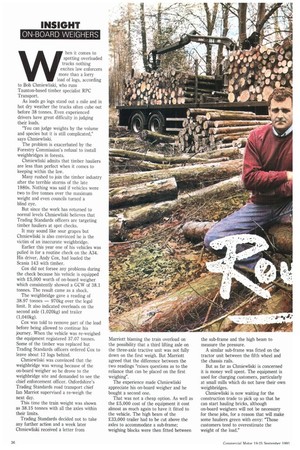W INF hen it comes to spotting overloaded nothing excites law
Page 38

If you've noticed an error in this article please click here to report it so we can fix it.
enforcers more than a lorry load of logs, according to Bob Chmiewliski, who runs Taunton-based timber specialist RPC Transport.
As loads go logs stand out a mile and in hot dry weather the trucks often cube out before 38 tonnes. Even experienced drivers have great difficulty in judging their loads.
"You can judge weights by the volume and species but it is still complicated," says Chmiewliski.
The problem is exacerbated by the Forestry Commission's refusal to install weighbridges in forests.
Chmiewliski admits that timber hauliers are less than perfect when it comes to keeping within the law.
Many rushed to join the timber industry after the terrible storms of the late 1980s. Nothing was said if vehicles were two to five tonnes over the maximum weight and even councils turned a blind eye.
But since the work has returned to normal levels Chmiewliski believes that Trading Standards officers are targeting timber hauliers at spot checks.
It may sound like sour grapes but Chmiewliski is also convinced he is the victim of an inaccurate weighbridge.
Earlier this year one of his vehicles was pulled in for a routine check on the A34. His driver, Andy Cox, had loaded the Scania 143 with timber.
Cox did not forsee any problems during the check because his vehicle is equipped with £5,000 worth of on-board weigher which consistently showed a GCW of 38.1 tonnes. The result came as a shock.
The weighbridge gave a reading of 38.97 tonnes — 970kg over the legal limit. It also indicated overloads on the second axle (1,020kg) and trailer (1,040kg).
Cox was told to remove part of the load before being allowed to continue his journey. When the vehicle was re-weighed the equipment registered 37.07 tonnes. Some of the timber was replaced but Trading Standards officers ordered Cox to leave about 12 logs behind.
Chmiewliski was convinced that the weighbridge was wrong because of the on-board weigher so he drove to the weighbridge site and demanded to see the chief enforcement officer. Oxfordshire's Trading Standards road transport chief Ian Marriot supervised a re-weigh the next day.
This time the train weight was shown as 38.15 tonnes with all the axles within their limits.
Trading Standards decided not to take any further action and a week later Chmiewliski received a letter from Marriott blaming the train overload on the possibility that a third lifting axle on the three-axle tractive unit was not fully down on the first weigh. But Marriott agreed that the difference between the two readings "raises questions as to the reliance that can be placed on the first weighing".
The experience made Chmiewliski appreciate his on-board weigher and he bought a second one.
That was not a cheap option. As well as the £5,000 cost of the equipment it cost almost as much again to have it fitted to the vehicle. The high beam of the £33,000 trailer had to be cut above the axles to accommodate a sub-frame; weighing blocks were then fitted between the sub-frame and the high beam to measure the pressure.
A similar sub-frame was fitted on the tractor unit between the fifth wheel and the chassis rails.
But as far as Chmiewliski is concerned it is money well spent. The equipment is used for charging customers, particularly at small mills which do not have their own weighbridges.
Chmiewliski is now waiting for the construction trade to pick up so that he can start hauling bricks, although on-board weighers will not be necessary for these jobs, for a reason that will make some hauliers green with envy: "Those customers tend to overestimate the weight of the load."




























































































